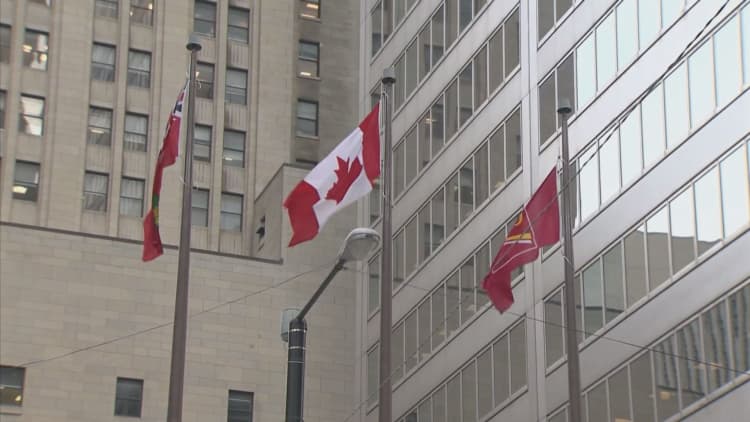Americans spend about $1,200 on prescriptions drugs a year, according to the latest figures from the Organization for Economic Cooperation and Development. That's more than people pay in any other developed country in the world.
In the past, pharmaceutical companies have attributed high prices to innovation, arguing that new and improved drugs are naturally more expensive. But a new study published in the journal Health Affairs complicates that idea.
It suggests that, largely, costs have gone up because companies are raising the price of drugs that are already available.
"We found that, in the case of brand-name drugs, rising prices were driven by manufacturers increasing prices of medications that are already in the market rather than [by] the entry of new products," lead author Inmaculada Hernandez, an assistant professor at the University of Pittsburgh School of Pharmacy, tells CNBC Make It.
'Out-of-pocket costs continue to soar'
Looking at wholesale data for around 27,000 prescription drugs, Hernandez and her colleagues found that, between 2008 and 2016, brand-name oral prescription drugs rose 9 percent annually, while injectable drugs increased 15 percent per year. Inflation, meanwhile, is only about 2 percent.
These percentage changes reflect list prices, which are set by manufacturers and don't fully match what consumers pay, since they don't account for rebates or insurance discounts.
Some increased prices, such as those for specialty and generic drugs, seem to be driven by the entry of new medications into the market, the researchers found. Otherwise, price increases don't necessarily reflect improvement or even change.
In 2014, the list price for a Sanofi brand of insulin called Lantus increased nearly 50 percent, for example, even though it had already been on the market for more than a decade. (The average net price, or what consumers pay, for Lantus has actually decreased in recent years, though, a spokesperson for Sanofi tells CNBC Make It.)
Pharmaceutical companies kicked off the new year with significant price hikes. Dozens of drugmakers raised the list prices of hundreds of medications an average of 6.3 percent on Jan. 1, according to a recent analysis from the health software company Rx Savings Solution.
"Those increases are examples of what we mean by year-over-year inflation in existing products," Hernandez says.
Gerard Anderson, professor of health policy and management at Johns Hopkins University, tells NPR that raising the cost of existing drugs benefits drugmakers and insurers.
"Research and development is only about 17 percent of total spending in most large drug companies," he says. "Once a drug has been approved by the FDA, there are minimal additional research and development costs so drug companies cannot justify price increases by claiming research and development costs."
The study did not examine why prices of existing drugs have gone up, but the researchers say a lack of competition and the regulatory environment in the U.S. allow "for price increases much higher than in other countries."

Critics contend that the study offers an "inaccurate portrayal of the U.S. marketplace," and they take issue with the fact that the researchers focused so much on wholesale price numbers.
"On average, 40 percent of the list price of medicines is given as rebates or discounts to insurance companies, the government, pharmacy benefit managers and other entities in the supply chain that often require large rebates in order for a medicine to be covered," says Holly Campbell, deputy vice president of public affairs for the Pharmaceutical Research and Manufacturers of America, which represents the drug industry.
"However," she adds, "these savings are often not shared with patients whose out-of-pocket costs continue to soar."
Raising drug prices affects everyone
When prices go up, it doesn't just affect Americans without coverage. It can have much broader ramifications.
"Rising drug prices affect uninsured or underinsured patients, patients with high-deductible plans, those in the deductible or doughnut hole phase of their plans, the government as a payer, and all Americans in the form of higher premiums," says Hernandez. The doughnut hole refers to a coverage gap where your drug spending has reached a certain limit, so you usually have to cover costs until you reach what's called your out-of-pocket maximum.
Uninsured Americans are three times as likely as adults with private coverage to postpone or skip a prescription because they can't afford it. And a 2016 survey found that even 14 percent of insured Americans said they didn't fill a prescription or skipped doses of their medication because of the cost.
William Shrank, chief medical officer of the University of Pittsburgh Medical Center Health Plan, and co-author of the Pittsburgh study, says their findings call for "policy efforts designed to control health-care spending by capping price inflation to some reasonable level." In other words, they suggest that lawmakers impose new limits on how much pharmaceutical companies can increase list prices.
Other countries have had success holding down drug prices by employing centralized price negotiations, according to the Commonwealth Fund, and minimizing out-of-pocket expenses by offering universal coverage.
The government has recently started pressuring drugmakers to make medications more affordable. President Donald Trump reportedly met with his advisors in January to address price hikes, according to Politico.
And California Gov. Gavin Newsom signed an executive order, only hours into his new job, directing the state to set up a single-purchaser system for prescription drugs, in hopes of holding down costs.
For at least a decade, a majority of Americans have been dissatisfied with the country's largely for-profit health-care system, according to Gallup. In one poll, 71 percent of respondents said the system is "in a state of crisis" or "has major problems." That's partly because costs are more expensive in the U.S. than elsewhere: Overall, the country spends twice as much as its peers, yet it gets poorer results.
Like this story? Like CNBC Make It on Facebook!
Don't miss: Here's the real reason health care costs so much more in the US



